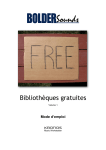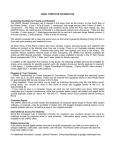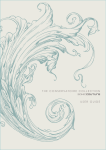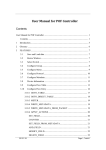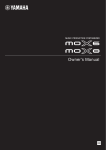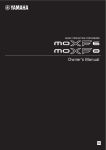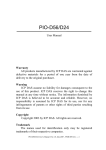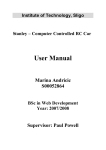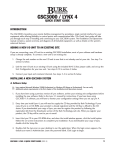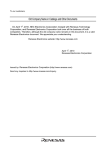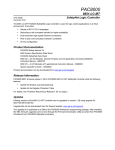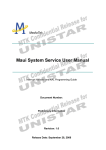Download freeHorn
Transcript
freeHorn
Larry Polansky
Software by Phil Burk and Larry Polansky
User Notes
(in progress)
12/5/06
Introduction
freeHorn is a stand-alone application. It has no inputs, only outputs. The
performer can modify its form, length, and behavior to make hisr own pieces.
freeHorn is written in Java using Phil Burk’s JSyn libraries. It is a Java .jar file, so
should run on any platform.
Before running freeHorn, you will need to download the JSyn plug-in from Phil
Burk’s Softsynth site.
http://www.softsynth.com/jsyn/
freeHorn, and the Psaltery set of pieces
freeHorn is an highly generalized software implementation of a set of pieces,
beginning with Psaltery (for Lou Harrison), in 1978. The form common to these
works is a continuous modulation, by some morphing or replacement algorithm,
between harmonic series on fundamentals related as simple integer ratios. In the
previous pieces, pitches up to the 17th harmonic are used, and the fundamentals
of the three series are related as 1:3:5:1 (often with octave equivalences).
Each section of the piece consists of one harmonic series “cross-fading” with the
previous one. The replacement algorithms for these has varied slightly, as has the
length, instrumentation, fundamental, and a few other things.
freeHorn
Polansky
User manual
(Original replacement diagram for Psaltery)
Although each piece has used a different instrumentation, all have used the first
17 harmonics, the progression 1:5:3:1 for the harmonic series, and some
replacement algorithm for the harmonics which specifies that a new harmonic (that
is, an entering harmonic from a new series) will replace the (still remaining)
harmonic from the old series which is closest in frequency. Each of these pieces
has used the following order of entry for new harmonics:
17, 13, 11, 14, 7, 15, 10, 5, 9, 12, 6, 3, 16, 8, 4, 2, 1
— which may be described as the decreasing order of harmonic prime
complexity. I call this, informally, “psaltery order” after its use in the first piece
in the set. Higher primes enter first, starting with their highest powers. The first
series enters, to begin the piece, in the opposite order (1, 2, 4, 8, 16, 3, 6, 9, 12, 5,
10, 15, 7, 14, 11, 13, 17), and the final “fade-out” of the first series, at the end of
the piece, consists of pitches dropping out in the order of entry (from high prime
to low).
2
freeHorn
Polansky
User manual
The pieces in this set include several written in the late 70s (Canon for Flute (for
flute and multitracked flutes), Flutes (for flute choir), 'Cello (for cello and
multitracked celli), Choir (for choir), and Glass (for 51 tuned water glasses)). Two
more recent works (Horn (1990) and Choir/Empi’s Solo (1997)), are computer
generated, and scored for tape and solo live performer.
For recordings and scores of many of the pieces in this set, go to my website:
http://music.dartmouth.edu/~larry
What freeHorn does
In freeHorn, the user can set the length of the piece, the form, and many of the
sonic and musical parameters. The form is specified by a set of ratios, which
determine how many sections the piece will have, as well as the fundamentals of
those sections. The software uses a replacement algorithm to compute the
progression between from one series and another.
For each new harmonic series (except the first, which enters in the reverse order
to that stated below), pitches enter in the order described above (assuming the
harmonics used are 1-17):
17, 13, 11, 14, 7, 15, 10, 5, 9, 12, 6, 3, 16, 8, 4, 2, 1
Highest primes enter first (shown now in boldface), and all multiples of these
primes are “used up” before the next prime enters. Primes enter from their
higher powers “on down.” This algorithm is a kind of simplified version of
functions like the Euler GS function (a measure of numerical complexity).
Thus, after the first series (on the first fundamental) has entered completely, the
next series begins replacing it by first replacing some pitch in the previous
(existent) series with pitches corresponding to the new fundamental’s 17th
harmonic, 13th, 11th, … 1st. In previous pieces, I’ve usually used a simple nearest
neighbor scheme for the replacement algorithm, but others are possible (at the
present time, freeHorn only implements one such algorithm, but there are “stubs”
for a few others).
Though the user specifies some number of sections by entering in a list of ratios
(real numbers, separated by colons), there is one additional section in the piece,
added automatically by the software.
sectionLength = totalLength/(numberHarmonicSeries + 1)
After the final specified series replaces the penultimate, pitches drop out from
most complex to most simple (17, 13, 11, … 16, 8, 4, 2, 1). This final (nonspecified) section is the same duration as the others. In other words, if the user
specifies three sections for the piece:
1 : 1.5 : 1.25 : 1
3
freeHorn
Polansky
User manual
— the piece will really consist of
1 : 1.5 : 1.25 : 1 : (1, drop out)
In other words, if the performer specifies a length of 10 minutes and four sections,
there will actually be five sections, each dividing the total duration more or less
evenly.
In the above example, the first thing to occur (section 1) is the build up of
harmonic series on 1 (times the fundamental). That series will then be replaced
(section 2) by the harmonic series on 1.5 times the fundamental (3/2 ratio, or a
perfect 5th), beginning with the new series’ 17th harmonic. That will in turn be
replaced (section 3) by a series on 1.25 times the fundamental (5/4 ratio, or a
major third), in similar fashion. The series on 1 will then replace the series on 1.25
(section 4), and will then “drop out” (section 5, added by the software) from
highest harmonic on down (thus, 4 ratios generate 5 sections).
Any ratios are possible, any number of sections (with the implicit assumption
that specifying, say, 13 sections actually yields a piece in 14 sections).
freeHorn uses mainly sine waves, though a little spectral complexity can be added
(see below). The performer can specify a number of parameters (duration range
and distribution, attack, decay, etc.).
Make your own piece
freeHorn is, after all, just a small piece of portable software which plays a lot of
sinusoids, and morphs between harmonic series. Please use it in any way you
like. Make your own piece(s), use it as part of other pieces, or use it as a tool for
music and experimentation as your imagination dictates.
4
freeHorn
Polansky
User manual
Interface and Features
The following is a feature-by-feature description of the freeHorn software,
documenting the user interface. There are three windows:
•
•
•
main window (where you can make your own version of the piece);
clock window (which tells you where you are in the piece);
JSyn waveform scope window (you can close that, it doesn’t really do much
except provide a simple oscilloscope for the sound).
In the main window, to change values, select the text box (will usually cause the
text area to be blue), type in new values, and hit enter. Most values need to be
entered as real numbers, with something before and after decimal point (the only
exception is the Section Ratios box).
Except for Total Length, Section Ratios, and Num Harmonics, all values may be
changed in real time during the piece.
Clicking on Start begins the piece with the current settings.
5
freeHorn
Polansky
User manual
Feature-by-feature Description of the Interface
Total Length
The length of the piece, in minutes. 10.5 minutes is 10’30”. The number of
sections specified in the Section Ratio box (plus 1, see above) divides the
length of the piece more or less evenly.
This value may not be changed once the piece has begun.
Section Ratios
This value may not be changed once the piece has begun.
These ratios might be simple harmonic ones (as in the default), but the
software allows the user to select any ratios whatsoever. The ratios must
be specified in decimal form. Thus, for the rational values:
1 : 7/4 : 3/2 : 11/8 : 5/4 : 1
— the user must type in
1 : 1.75 : 1.5 : 1.375 : 1.25 : 1
The first series does not have to be 1. For example, the structure 3:5:7, is
fine, but the fundamental is still considered to be 1. That is, the first series
would be built on harmonics of a pitch 3 times the fundamental.
Fundamental Freq
The frequency, in Hertz (cycles per second), to which all other frequencies
in the piece relate. This is, in some way, the “key” of the piece. For
example, if this is set to 100 Hz, and the first section ratio is 1, the first
harmonic series created will be 100 Hz, 200, 300, … 1700. If the second
section ratio is 1.5, the frequencies of that section will be 150 Hz, 300, 450,
600, … 2550.
This value may be changed in real-time.
Num Harmonics
This specifies the number of harmonics that each series will use. Typically,
I use 17. Note that since each section more or less divides the total
duration of the piece, the number of harmonics will divide the section’s
duration more or less equally. The musical result of this is that the more
harmonics, the more active the modulation will be (that is, the piece will
change more rapidly).
This value may not be changed once the piece has begun.
Duration Mean
6
freeHorn
Polansky
User manual
The mean duration for sound events. Values will be chosen by a kind of
Gaussian (or bell curve) function around this mean. See Duration Range,
Min, and Max for related parameters.
Values are specified in seconds, as real numbers. 0.5 is ½ second.
Long values for duration mean will create more drone-y, static, choralelike textures. Short values will create a more events.
Duration Range
This is a value centered on the Duration Mean, with limits specified by the
Duration Min and Duration Max.
The specification and computation of duration in freeHorn is a little
unusual. The range is the argument to the standard Gaussian algorithm,
specifying the width of the bell curve. The min and max are independent
of that. If either is within the range, the values will simply be clipped. This
allows the user to create some assymetric Gaussian distributions about a
mean. The code is as follows:
public static double nextGaussian( double mean, double
range, double min, double max )
{
// gaussian distribution scaled by range,
added to mean
double gauss = (random.nextGaussian() *
range) + mean;
// clip to min and max
if( gauss > max ) gauss = max;
else if( gauss < min ) gauss = min;
return gauss;
}
nextGaussian is the standard Java method that returns a “normal”
distribution with mean = 0, SD = 1. The SD is multiplied by the range, and
added to the mean. A small range will result in a tighter curve around the
mean; a large range will spread durations more around the mean (up to
min or max). The mean need not be centered between min max; they are
hard limits.
The best way to gain a “feel” for how this all works is to try different sets
of values, beginning with some conservative, simple ones (say mean = 1,
min = .25, max = 1.5, range = 3. Different combinations will yield different
duration distributions and thus, different musical behaviors for the piece.
All of these values may be changed in real-time.
Attack Min
7
freeHorn
Polansky
User manual
Minimum time, in seconds, of attacks. A Gaussian distribution between
Attack Min and Attack Max chooses attack times.
Attack Max
Maximum time, in seconds, of attacks. A Gaussian distribution centered
between Attack Min and Attack Max chooses attack times.
Decay Min
Minimum time, in seconds, of decays. A Gaussian distribution centered
between Decay Min and Decay Max chooses decay times.
Decay Max
Maximum time, in seconds, of decays. A Gaussian distribution centered
between Decay Min and Decay Max chooses decay times.
Duration Min
Minimum duration that will be picked by the software for a note during
the piece (see Duration Mean, Duration Range).
Duration Max
Maximum duration that will be picked by the software for a note during
the piece (see Duration Mean, Duration Range).
Inter Event Rest
Within a given voice, there are silences between events. The interEventRest
specifies the values that the software uses to determine how long to wait
between the next event in a given polyphonic segment of a voice. This is
specified as a % of the duration, after the duration is computed in the
usual way. That is there are currently 4 notes sounding in a given voice
(playing one harmonic), and one ends, the interEventRest time is how long
the software will wait before “filling up” the polyphony with the desired
fourth event.
The performer specifies a number, as a fraction of the durationRange, for
the interEventRest. The software multiples that number by the
durationMean, and then computes inter-event rests on an event-by-event
basis stochastically using a Gaussian distribution with that value as the
mean, and the durationRange * interEventRest as the range around that
mean. The simplest way to think of it is that these interEventRests will be
some fraction of the mean duration.
Note that rests, as specified in the above restProbability, count as events.
That gives the user several different, not necessarily independent ways, to
control the overall density “feel” of the piece.
Rest Probability
8
freeHorn
Polansky
User manual
The probability that instead of playing a note, there will be a silence for
the duration that would have otherwise been selected for that note. This
value and Inter Event Rest are two, independent ways of varying density.
Spectral Complexity
A value between 0 and 1 that adds harmonics to the sinusoids, which
comprise the piece. These harmonics are added by a simple waveshaper,
the value of Spectral Complexity determines, in a simple way, the degree
of deformation of the sinusoids. A value of 0 will result in pure sine
waves; a value of 1 will result in a richer, noisier, brighter spectrum.
Loudness
A simple loudness scalar for the entire piece. 1.0 is full, 0.0 is silent. This is
just a way of turning the output of the software up or down from the
screen. It is independent of the computer’s own volume control.
Pitch Scaling Factor
Not documented yet
Pitch Scale By
Not documented yet
Replace
Not documented yet
The Clock Window
This window shows:
•
•
•
•
the actual running time of the work (as a clock)
the CPU load (usually this can be ignored, but it can be a diagnostic
against using too many voices)
the section the work is currently in (updating as sections change, 1-n)
a current list of the “activity” of the piece at the moment (e.g “3.0 * 17
replacing 1.0 * 17”, meaning that the 17th harmonic of the 3 series is
currently replacing the 17th harmonic of the 1 series)
Some Performance Notes and Suggestions
• You can run as many versions of freeHorn, at the same time, as your computer
can handle (it’s pretty efficient, shouldn’t use much processor time). Each
version you run is independent of the others (they each have their own
clocks, formal structure, fundamentals, etc.). This is a good way to make
canons, thicken the texture, allow for very complicated simultaneous
harmonic fabrics, and so on. You can sync them by simply hitting START
reasonably close together.
•
There’s not much done with stereo spacing in freeHorn. Note events are
“panned” out to the stereo field in simple, kind of random way. If you want
different versions of the piece to go to different sets of speakers or mixer
channels, use several laptops.
9
freeHorn
Polansky
•
User manual
Interesting performances can be created with unusual section ratios, which
may involve complex real-number relationships. I sometimes use very small
ratios, such as 1: 1.001: 1.003: 1, which means that the harmonic compass of
the piece will be quite small, but that the replacement algorithms will
generate a lot of beating and dissonance.
Notes, bugs, things I need to improve (but may not get around to):
1) Right now there is no way to save the settings, so that you can easily
repeat a performance. Sorry. I usually just jot them down.
2) It’s good to pick low fundamentals for the Fundamental Frequency. The
harmonics picked by the software are in their proper octave, so they can
get quite high.
3) I should add sliders for the values, and ways to move multiple values at
once.
4) There should be ranges for amplitude, spectral complexity, maybe other
values (even the fundamental), like the duration range.
Acknowledgements (notes)
freeHorn is written in Java and Phil Burk’s Jsyn API. Jsyn is written by Phil Burk.
The software was designed by the composer and Phil Burk, and written by Phil
Burk with assistance from the composer. freeHorn was commissioned by Kirsten
Barrow
Thanks to Evan Geiger, Phil Burk, David Dunn, Ed Carroll, Benedict SchlepperConnolly and others who have performed this piece, made suggestions, and
helped in various ways.
Lp
12/15/06
rev. 1/10/07
10
Some Example Settings
Example 1
freeHorn with Neil Sweeney (sax), 25 november 2006, Benedict Schlepper-Connolly,
computer.
Sligo, Ireland, The Printing House Festival of New Music
(These are the settings for different times in the piece, which change
10 mins (total duration)
fundamental 58.43
decay min 0.2
decay max 1.0
0:00
1:00
2:00
3:00
4:00
5:00
6:00
7:00
8:00
9:00
10:00
num harm 17
duration min 0.05
rest probability 0.5
dur. Max
0.5
1.0
2
4
8
16
8
4
2
1.0
0.5
dur. Min
0.05
0.05
0.05
0.05
0.1
5
0.1
0.05
0.05
0.05
0.05
section 1:1:3:5:8
interevent rest 0.5
loudness 0.5
attack min 0.01
spect. complexity 0.1
dur. Mean
0.2
0.4
0.8
1.6
3.2
6.4
3.2
1.6
0.8
0.4
0.2
Example 2
freeHorn Canon
6/28/06
International Trumpet Seminar performance, 6/30/06
Enfield, New Hampshire
10 trumpets, computer, fretless elecric guitar
Two versions of the same program (duration and other settings not included here), run
“in canon” by starting the second version of the program 5’35” into the piece. Score
example shows written score for trumpets in Bb, voice 1.
Harmonic progression (data for program)
1 : 1.083 : 1.166 : 1.125 : 1.0416 : 1
Ratio equivalents
1 : 13/12 : 14/12 : 27/25 :25/24 : 1
(Bb: 58.2705 Hz.)
Voice 1, duration 720 seconds (12 minutes)
Voice 2, duration 445 seconds, (7:25 minutes)
Voice 2 starts a 4:35














